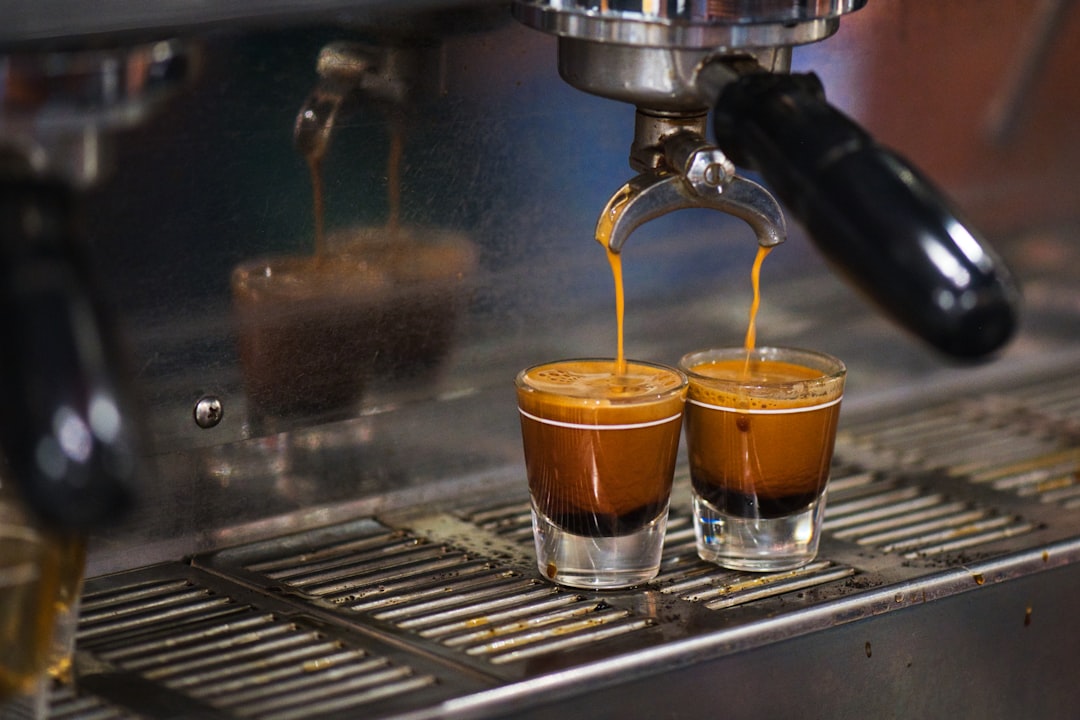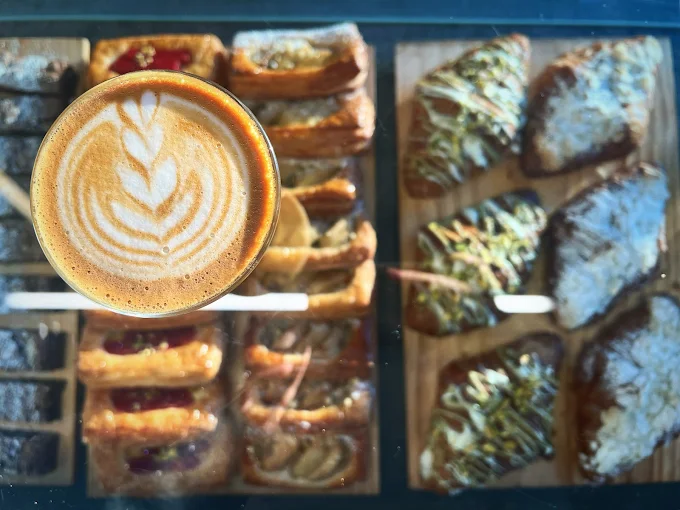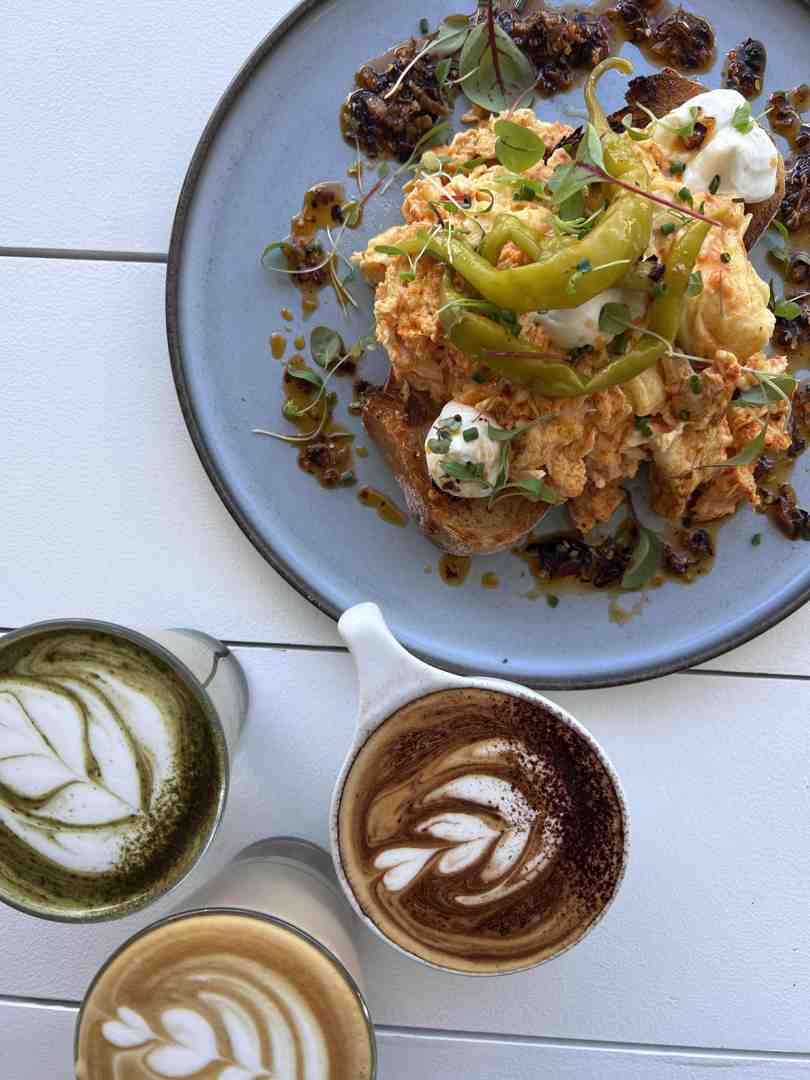Beginner's Guide to Brew Coffee vs Espresso

Understanding the Key Differences Between Brew Coffee and Espresso
Brew coffee vs espresso might seem like a simple choice, but the differences go far beyond cup size. Here's what sets them apart:
Quick Comparison:
- Brewing Method: Espresso uses high pressure (9-15 bars) for 25-30 seconds; brewed coffee uses gravity over 4-6 minutes
- Grind Size: Espresso needs fine grounds; brewed coffee uses medium to coarse
- Caffeine: Espresso has 40mg per ounce vs brewed coffee's 10mg per ounce, but a full cup of brewed coffee contains more total caffeine
- Taste: Espresso delivers bold, concentrated flavour with crema; brewed coffee offers smoother, more subtle notes
- Serving Size: Espresso comes in 1-2oz shots; brewed coffee typically served in 8-12oz cups
The real difference isn't the beans themselves - it's all about the brewing method. At Flinders Lane Cafe in Maroochydore, we use the same quality beans for both our espresso shots and batch brew, but the way we extract them creates completely different experiences.
Whether you're after a quick caffeine hit before exploring the Sunshine Coast or settling in for a slow catch-up with mates (furry friends welcome too!), understanding these differences helps you choose the perfect cup for your moment.
I'm Janice Kuz, and after over 20 years in hospitality, I've seen how brew coffee vs espresso preferences shape people's daily rituals at our welcoming Maroochydore cafe. My experience has taught me that the best cup isn't just about brewing technique - it's about matching the right coffee to your lifestyle and mood.
What Makes Them Different: Brewing Methods Explained
The magic behind brew coffee vs espresso isn't in the beans themselves - it's all about how we coax the flavours out of them. Think of it like the difference between a quick sprint and a leisurely walk; both get you where you're going, but the journey shapes the experience completely.
At Flinders Lane Cafe, I love watching our customers find these differences. Some dash in for a quick espresso shot before heading to the beach, while others settle in with a slow-drip coffee for a proper catch-up (and yes, your furry mate is welcome to join you on our pet-friendly deck!).
The real difference comes down to pressure versus patience. Espresso uses intense pressure to extract flavours in seconds, while brewed coffee lets time and gravity do the gentle work.
Espresso in 30 Seconds
Espresso is coffee's answer to speed dating - intense, concentrated, and over before you know it. But don't let the quick timing fool you; there's serious precision happening in those 25-30 seconds.
Our baristas start with finely ground coffee - we're talking powder-fine, almost like flour. This gets tamped down into a tight puck in the portafilter, creating the perfect resistance for what comes next.
Then comes the pressure - 9-15 bars of it, forcing hot water through those compressed grounds. The water temperature sits around 200°F, hot enough to extract all those lovely oils and compounds but not so hot it burns them.
The result? That gorgeous golden crema floating on top tells you everything went right. It's formed when dissolved CO₂ comes out of solution under pressure - basically, the coffee's way of showing off.
What makes espresso special is how this high-pressure extraction pulls out oils, proteins, and sugars quickly, creating that signature thick body and intense flavour that cuts through milk beautifully in lattes and cappuccinos.
Gravity-Brewed Coffee Basics
Brewed coffee takes the scenic route to your cup. Instead of pressure doing all the work, we let time and gravity create something completely different from the same beans.
The grind size shifts to medium coarse - think chunky sea salt rather than flour. This coarser grind allows water to flow through more slowly, giving it time to extract different compounds from the coffee.
The process starts with the bloom phase - when hot water first hits the grounds, you'll see them puff up and release CO₂. It's like the coffee taking a deep breath before the real extraction begins.
Water temperature runs slightly cooler at 195-205°F, and the whole process takes 4-6 minutes rather than seconds. This gentler approach pulls out more subtle flavours while paper or metal filters catch the grounds and some of the oils.
The water-to-coffee ratio tells the story too - espresso uses about 1:2 ratio (coffee to water), while brewed coffee spreads out to 1:15 or 1:18, creating that familiar cup size perfect for sipping slowly.
This slower extraction method is why brewed coffee often tastes smoother and more nuanced. You're getting different compounds than the high-pressure espresso method, which is why the same beans can taste so different between our batch brew and espresso shots.
For more coffee terminology that might help on your coffee journey, have a look at our guide From Flat Whites to Batch Brew: A Beginner's Guide to Coffee Lingo.
When you understand these brewing differences, the brew coffee vs espresso choice becomes clearer. Espresso's fine grind and high pressure create intensity and crema, while brewed coffee's coarser grind and gentle extraction develop complexity and smoothness. Both methods have their place - whether you're grabbing a quick shot before exploring Maroochydore or settling in for a long chat with mates at our Flinders Lane location.
Key Variables Comparison:
| Variable | Espresso | Brewed Coffee |
|---|---|---|
| Grind Size | Fine (like flour) | Medium to coarse |
| Water Ratio | 1:2 (coffee to water) | 1:15 to 1:18 |
| Pressure | 9-15 bars | Atmospheric (gravity) |
| Time | 25-30 seconds | 4-6 minutes |
| Temperature | 190-196°F | 195-205°F |
Brew Coffee vs Espresso: Taste, Texture & Caffeine Breakdown
The real magic happens when you take that first sip. The brew coffee vs espresso experience is like comparing a whisper to a shout - both have their place, but they'll affect you in completely different ways.
After two decades of watching customers' faces light up with that first taste at our Maroochydore cafe, I can tell you that understanding these differences will transform how you think about your daily coffee ritual.
Brew Coffee vs Espresso Concentration
Here's where most people get surprised - and it's probably the opposite of what you'd expect about brew coffee vs espresso.
Espresso is incredibly concentrated at around 63mg of caffeine per ounce, while brewed coffee sits at about 12mg per ounce. So yes, espresso packs more punch per sip.
But here's the twist that catches everyone off guard: most of us don't drink coffee by the ounce. When you order a double shot espresso at our Flinders Lane location, you're getting about 126mg of caffeine in 2 ounces. Meanwhile, that 8-ounce cup of our batch brew delivers around 96mg, and a larger 12-ounce mug pushes up to 144mg.
It's like comparing a shot of spirits to a glass of wine - different concentrations, different experiences, different effects on your morning.
The way your body processes them differs too. Espresso hits fast - you're downing that caffeine in about 30 seconds of drinking. Brewed coffee is a slow release as you sip over 10-20 minutes, which many of our customers find gentler on their system. Perfect for those long catch-ups with mates (and their four-legged friends) on our pet-friendly outdoor tables.
Sensory Experience
The taste difference between brew coffee vs espresso is where things get really exciting. It's the same quality beans we use for both, but the brewing method acts like different camera lenses - each one shows you a completely different side of the coffee's personality.
Espresso delivers intensity in every aspect. That thick, syrupy mouthfeel coats your palate, while the concentrated flavours hit bold and punchy. The aroma is immediate and rich, and that golden crema layer adds a sweet, caramel-like complexity that makes espresso lovers swoon. The finish? Bold and lingering, like a great conversation that stays with you.
Brewed coffee takes the scenic route. It's lighter and more refreshing, with a gentle aroma that invites you to slow down. The flavours are subtle and nuanced - you can actually taste individual notes dancing on your tongue. When we use paper filters for our batch brew, it creates clean, bright flavours that let the coffee's natural character shine through. The finish is smooth and often more acidic, which highlights those lovely fruity notes.
What fascinates me most is how espresso tends to highlight the roasty, chocolatey notes in our beans, while our batch brew brings out more of the fruity and floral characteristics. Same beans, completely different stories. It's like hearing your favourite song performed by different artists - recognisable, but each version reveals something new.
The antioxidant profiles differ too. Espresso's high-pressure extraction pulls out different compounds than the gentle gravity method of brewed coffee, which means you're getting varied health benefits from each cup. Both are excellent sources of antioxidants, but they deliver them in different concentrations and combinations.
Choosing the Right Cup for Your Lifestyle
After two decades of watching customers at our Maroochydore cafe, I've learned that the brew coffee vs espresso choice isn't just about taste - it's about how coffee fits into your day. Some mornings you need that quick espresso hit before heading to the beach, other times you want something gentle to sip while your dog settles in beside our outdoor tables.
The beauty of understanding brew coffee vs espresso differences is matching the right brew to your moment. Whether you're catching up with mates on a lazy Saturday or grabbing fuel for a busy workday, each brewing method serves its purpose.
When Smooth Matters: Cold Brew & Drip
Sometimes your stomach needs a gentler approach, or the Queensland heat calls for something refreshing. That's when brewed coffee becomes your best friend.
The lower acidity in cold brew and drip coffee makes all the difference for sensitive stomachs. Cold brewing can reduce acidity by up to 70% compared to hot extraction methods, according to scientific research on mineral content. The longer, cooler steeping process pulls out fewer harsh compounds while preserving the smooth, naturally sweet flavours.
Our 12-24 hour cold brew process creates a concentrate that's perfect for those sweltering Maroochydore afternoons. We can serve it over ice, dilute it to your liking, or even prepare it the night before so it's ready when you wake up. It's become a favourite among our regulars who want their caffeine without the intensity.
Drip coffee offers similar gentleness with the warmth many of us crave. The paper filters catch oils and fine particles, creating a clean, bright cup that lets subtle flavour notes shine through. Perfect for those long conversations at our pet-friendly tables where you want something that won't overwhelm your palate over an hour of sipping.
When Bold Wins: Espresso Shots & Milk Drinks
When you need maximum flavour impact in minimum time, espresso steps up. But here's what many people don't realise - espresso isn't just about drinking it straight (though some of our customers absolutely do). It's the powerhouse behind Australia's beloved milk-based coffee culture.
The concentrated nature of espresso means it holds its own beautifully against steamed milk. When we pull a perfect double shot and combine it with our expertly steamed milk, you get drinks like our signature flat white - where the espresso's bold character still shines through that silky microfoam.
Ristretto shots offer even more intensity for those who want maximum punch, while lungo shots provide a slightly milder but still concentrated experience. The versatility means we can craft everything from a delicate macchiato (just a dollop of milk foam) to a comforting latte with plenty of steamed milk.
For those interested in exploring the nuances of milk drinks, our guides on Everything You Need to Know About the Difference Between Flat White and Cappuccino and Steamed Milk Showdown: Latte vs Cappuccino dive deeper into these popular choices.
Espresso also aids digestion, which is why it's traditionally enjoyed after meals. Many of our brunch customers finish their eggs benedict or avocado toast with a piccolo or short black - the perfect punctuation to a satisfying meal.
The recipe versatility of espresso means endless possibilities. Whether you're after a quick macchiato before a morning surf, a cappuccino to share gossip with friends, or a dirty chai when you can't decide between coffee and spice, espresso forms the foundation that makes it all possible.
Home Brewing Pros & Cons
The brew coffee vs espresso conversation doesn't end when you leave our Maroochydore cafe. We love hearing from customers who've caught the coffee bug and want to recreate their favourite flavours at home - though the reality can be quite different from the dream!
Let's be honest about what you're getting into. Brewed coffee is definitely the friendlier option for home brewing. You can grab a decent pour-over setup or French press for under $50, and even if your technique isn't perfect, you'll still end up with something drinkable. The process is forgiving - water too hot? It'll still work. Grind slightly off? You'll survive.
The beauty of brewed coffee at home is the ritual itself. There's something therapeutic about the slow pour, watching the coffee bloom, and having those few minutes to yourself before the day kicks in. Plus, you can easily make enough for the whole household or when mates drop by.
Espresso at home, on the other hand, is like learning to drive a manual car after years of automatic. The initial investment alone can be eye-watering - we're talking anywhere from $500 to several thousand for equipment that'll actually produce something resembling what we serve here. And that's before you factor in the learning curve.
Here's what nobody tells you about home espresso: you'll probably waste a lot of expensive beans getting it right. The grind needs to be spot-on, your tamping pressure consistent, and your timing precise. Too coarse and it'll taste sour, too fine and it'll be bitter. It's a science that our baristas have spent years perfecting.
But when you nail it? There's nothing quite like pulling that perfect shot in your own kitchen. The thick crema, the rich aroma, the satisfaction of creating something genuinely impressive - it's addictive.
Gear Checklist & Tips
If you're determined to give home brewing a crack, here's what actually matters based on our professional experience.
For brewed coffee success, invest in a decent burr grinder first - it makes more difference than expensive brewing equipment. Those blade grinders create uneven particles that extract at different rates, giving you muddy, inconsistent results. A digital scale is your second priority because eyeballing coffee-to-water ratios is like trying to bake a cake without measuring ingredients.
For espresso trips, you'll need a machine that can actually hit 9 bars of pressure (many cheap ones can't), a grinder with fine adjustment capabilities, and patience. Lots of patience. Start with a single-origin bean that's forgiving - blends can be trickier to dial in.
Here's something that surprises people: you can absolutely use the same beans for both methods. We sell our house blend to customers who make both espresso and pour-over at home. The magic is in adjusting your grind size and technique, not buying different coffee.
The environmental impact is worth considering too. Home brewing means less takeaway cups, less driving to cafes, and you can choose exactly how sustainable your setup is with reusable filters and ethical bean sourcing.
Of course, there's something to be said for leaving it to the professionals. When you visit us at Unit 2/31 Flinders Lane, you're getting years of expertise, perfectly calibrated equipment, and no morning frustration when things go wrong. Plus, you get the social aspect - catching up with friends in our pet-friendly space while we handle the technical stuff.
For more insights into creating the perfect coffee experience, check out our Beginner's Guide to the Difference Between Flat White, Latte and Cappuccino.
Frequently Asked Questions about Brew Coffee vs Espresso
After two decades of serving coffee lovers in Maroochydore, these are the questions we hear most often about brew coffee vs espresso. Let me clear up some common confusion with straight answers from our experience behind the coffee machine.
Does espresso have more caffeine than a regular cup?
This one always sparks interesting conversations at our outdoor tables! The answer depends on how you measure it, and it's probably not what you'd expect.
Per ounce, espresso absolutely wins - it packs about 63mg of caffeine per ounce compared to brewed coffee's 12mg. But here's where it gets interesting: most people don't drink coffee by the ounce.
When you order our batch brew, you're getting an 8oz cup with around 96mg of total caffeine. Compare that to a single espresso shot at 63mg, and suddenly that "weaker" brewed coffee is delivering more caffeine overall.
The real difference is in how quickly you consume it. Down an espresso shot in 30 seconds, and that caffeine hits your system fast - which is why it feels more intense. Sip a cup of brewed coffee over 15 minutes during a catch-up with mates (dogs welcome on our pet-friendly deck!), and you're getting a gentler, sustained energy boost.
If you want maximum caffeine, go for our double shot flat white - you'll get the concentrated espresso kick plus the satisfaction of a larger drink.
Can I use the same beans for both methods?
Absolutely, and this might be the biggest coffee myth we bust daily! There's no such thing as special "espresso beans" - it's all about how you brew them.
At Flinders Lane Cafe, we often use the same quality beans for both our espresso shots and batch brew. The magic happens in the preparation: fine grind and high pressure for espresso, medium grind and gravity for brewed coffee.
What matters more than the bean type is freshness and roast level. Darker roasts tend to work beautifully for espresso because they're less acidic and have more body to stand up to milk in lattes and cappuccinos. Medium roasts can shine in both methods, bringing out different flavour notes depending on how they're brewed.
The key is matching your grind size to your brewing method. Take the same beans home, and you can make espresso-style coffee with a Moka pot or smooth drip coffee with a pour-over - just adjust your technique.
Which brew is gentler on sensitive stomachs?
If you love coffee but sometimes find it a bit harsh, brewed coffee is definitely your friend, especially our cold brew options.
Cold brew can be up to 70% less acidic than hot-brewed coffee and significantly gentler than espresso. The cold extraction process that takes 12-24 hours pulls out fewer of those acidic compounds that can upset sensitive stomachs.
Paper filters in drip brewing also remove many of the oils that can cause digestive discomfort. Espresso, being unfiltered, contains more of these natural oils - they contribute to that rich mouthfeel, but they're not always stomach-friendly.
There's also the pace factor. When you're settling in for a slow morning on our Maroochydore deck, sipping brewed coffee gradually is much easier on your system than knocking back a concentrated espresso shot.
If you're an espresso lover but find it too intense, try our long black - it's a double shot topped with hot water, giving you that espresso flavour in a more diluted, gentler form. Perfect for easing into the stronger stuff or when you want espresso character without the intensity.
Conclusion
The brew coffee vs espresso choice doesn't have to be an either-or decision. After two decades of serving coffee in Maroochydore, I've watched countless customers find that the real magic happens when you understand what each brewing method brings to your day.
Some mornings call for the bold intensity of a double-shot flat white - that perfect marriage of concentrated espresso and silky steamed milk that cuts through the Queensland humidity and gets you moving. Other days, you want to settle in with a smooth batch brew, watching the world wake up from our outdoor tables while your four-legged mate snoozes at your feet.
The beauty of understanding brew coffee vs espresso is that you're no longer limited to one experience. Maybe you start your morning with a quick espresso hit, then return later for a leisurely catch-up over our gentle batch brew. Perhaps you're someone who loves the ritual of a perfectly crafted cappuccino but finds cold brew is your afternoon go-to when the Sunshine Coast heat kicks in.
At Flinders Lane Cafe, we've built our reputation on making both methods shine. Our espresso forms the heart of classics like our flat whites and lattes, while our batch brew showcases the subtle, nuanced flavours that make coffee such a fascinating drink. Same quality beans, completely different personalities.
What matters most isn't whether you're team espresso or team brewed coffee - it's finding the cup that makes your moment better. Whether that's fuelling up before a beach walk, powering through an afternoon slump, or creating the perfect backdrop for those important conversations with friends.
We're here at Unit 2/31 Flinders Ln, Maroochydore QLD 4558, ready to help you explore both worlds. Our pet-friendly outdoor seating makes us the perfect spot for those long catch-ups where you can really experience the difference between a punchy espresso and a smooth, sippable brew.
After all these years in hospitality, I've learned that the best cup isn't necessarily the technically perfect one - it's the one that fits your mood, your day, and your moment. Sometimes that's a quick double shot before hitting the beach. Other times it's a leisurely mug of our batch brew while planning your day or catching up on messages.
Come taste the difference for yourself. Try our espresso in a classic flat white or long black, then compare it to our smooth batch brew served black or with a splash of milk. You'll leave with a better understanding of what makes each method special - and probably a new favourite way to start your Maroochydore mornings.
We're here every day, ready to craft whichever style suits your moment. Because whether you're brew coffee vs espresso team, what really matters is that perfect cup that makes everything else feel just a little bit better.





